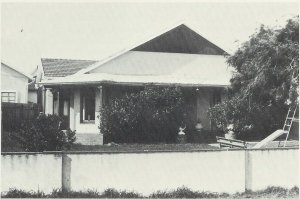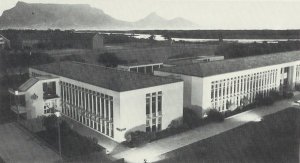|
||
|
Chapter 23 - Civic Spirit The humane attitude adopted by the Council in regard to its own employees was demonstrated in a curious incident in 1964. It was discovered that "for some inexplicable reason, 100 miles travelled by the municipal Ford van could not be accounted for by the driver". The only explanation he put forward was that, owing to some faulty mechanism, the speedometer had "jumped". Confronted with this story the Town Clerk and Town Treasurer set about the preparation of a revised Log Book to ensure that such errors could be spotted immediately. The Council thereupon accepted the driver's explanation. Milnerton's municipal machine was running with smoothness and efficiency, a fact that added significance to the instructions given on February 19, 1964, for the preparation, by an architect, of plans for new offices with approximately 10 000 square feet of space. Improved relations with Cape Town were shown by a loan from its Treasury of R200 000, repayable with interest at 7 per cent, in half-yearly instalments of R9 365.46 each. Another loan of the same size followed within a few months. May 1965 marked a milestone in the progress of Milnerton when the tender of Beekman & Theunisen (Pty) Ltd. at R165 000 was accepted for constructing the first section of the Municipal Offices. Roof-wetting took place on February 25, 1966 and five months later, on July 20, came the formal inauguration, when Councillor F. G. Kotze, the Mayor, welcomed leading citizens from his own and also neighbouring communities, the whole event, as he put it, being the result of three years' intensive work. "For my councillors and myself," said His Worship, "this is a very proud night, for we, who have done so much spade-work amidst the most adverse conditions, rightly have the honour of being the first Councillors to meet in this Chamber. . ." The Administrator of the Cape Province, Dr. Nico Malan, who attended the ceremony, declared his supreme confidence in the prospects of Milnerton, adding that, if he had money to invest, it would be his first choice. After the formalities, the Town Clerk was given authority "to call for quotations for moving office furniture and equipment to the new Administrative Block or alternatively to use Municipal vehicles and labour". With the migration to the new Municipal Offices also went an in crease in the formality of civic proceedings, the regulations adopted included a whole series of sartorial provisions. "At every Council Meeting every Councillor and the Town Clerk shall be properly gowned and the Chains of Office worn by the Mayor and Deputy Mayor, unless the Mayor directs otherwise. "At all Meetings of the Council and of occasional Committees appointed by the Council, Councillors shall be suitably attired, provided that, where inspections in the field are required to be undertaken, dress appropriate for such inspections may be worn, the determination of being suitably attired to be at the discretion of the Mayor or Chairman." Moreover every Municipal employee appearing before the Council or Committee was also to be "suitably attired", and, in the case of those entitled to wear such a garment, in uniform. Mayors and Mayoresses were entitled to a commemorative medallion. Several experts were consulted by the Municipality in connection with the coat-of-arms, including the well-known sculptor, Ivan Mitford-Barberton, the former Chief Archivist, Dr. Coenraad Beyers, and Dr. C. Pama. Milnerton's 1966 Municipal Election was unusually exciting since there now were eight Councillors in the place of six. A number of new "Independents" aroused fresh public interest in civic development, namely A. S. Sher, Mrs. E. Waddington and Vic Bird who stood against the eight nominees of the Ratepayers' Association. Crowded meetings were held in the Jansen Road Hall and voters were brought in from many distant points to vote at the election. New schemes in township expansion, traffic control, etc., were taken in hand, to say nothing of the new municipal offices. A dynamic period in Municipal administration had commenced.
Scarcely had the settling-in process been completed than further improvements in efficiency were undertaken, notably the acquisition of an electronically-controlled accounting machine. Following the establishment of the new suburb of Bosmansdam, presently renamed Bothasig, after Mr. P. W. Botha, then Minister of Community Development and now Prime Minister, which gave change to the make-up of the population in the Municipality it was necessary to increase the staff acquainted with "Snelskrif' since "more and more correspondence will be done in Afrikaans". Regrading of personnel was also undertaken. Reviewing the progress of the first 10 years of Milnerton's existence, the Town Clerk reminded the Council that, on September 1, 1955 "The staff consisted of myself, a Junior Clerk (1. Parkin), a Shorthand Typist cum Telephonist cum Records Clerk, and one Foreman (A. G. Soule), as well as a Plumber named Van Schalkwyk". Further territorial adjustments were periodically needed and the Director of Local Government was asked to take up settlement of rival town-planning schemes. To one such complication Councillor F. G. Kotze drew attention on May 29, 1967. "In view of the proposed development by the Cape Town City Council of the whole of Sanddrift, Montague Gardens Residential Township and a portion of Tygerhof for housing, Council should agree to negotiate on the basis of a possible readjustment of the boundary between Milnerton and Cape Town." On this occasion His Worship put forward the suggestion that a future line of separation should run along the De Grendel Road from Koeberg to the Malmesbury National Road. So too approval was given in 1967 to the incorporation into the Municipality of 1 610 morgen of unsubdivided land, owned by the Milnerton Estates, north of Table View Township. Spectacular progress in the physical growth of Milnerton in these years is brought home by the remark of the Mayor, who indicated that during 1966 and 1967 the Municipal valuation had risen from R12 000 000 to R27 000 000, a spurt rarely, if ever, equalled in the history of South Africa. Memories of bygone days were revived among older citizens as they watched
the railway construction teams at work. Covering a distance somewhat longer
than the original line from Cape Town to the Racecourse, the new privately-owned
Milnerton Railway to Montague Gardens was entirely industrial in its purpose,
being designed to serve a series of sidings, in the new Petro-Chemical
Complex. Fisons Fertilizer Works and Caltex were to provide the initial
traffic. This involved building two rail-over-road bridges; one crossing
the national highway to Bellville and the other the section between Milnerton
and Bothasig. The cost was estimated round R1 000000, and construction
began in the middle of 1967. Not only Milnerton but South Africa generally lost one of its best liked citizens in August 1967, with the passing of Major-General Frank Theron. In its tribute to that distinguished soldier the Council expressed deep personal regard but also gratitude for "the great and valuable services he had so frequently given to the town and people of Milnerton, particularly in his capacity as a member of the Ratepayers' Association".
|
||
|
|
||


